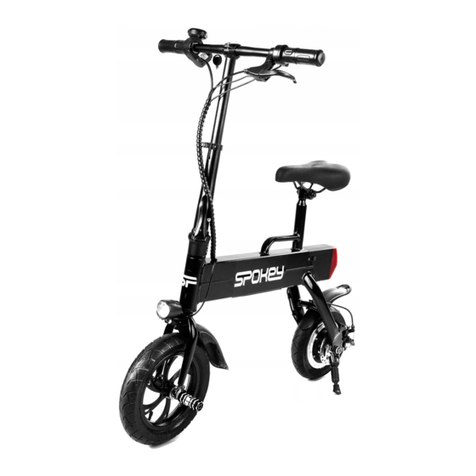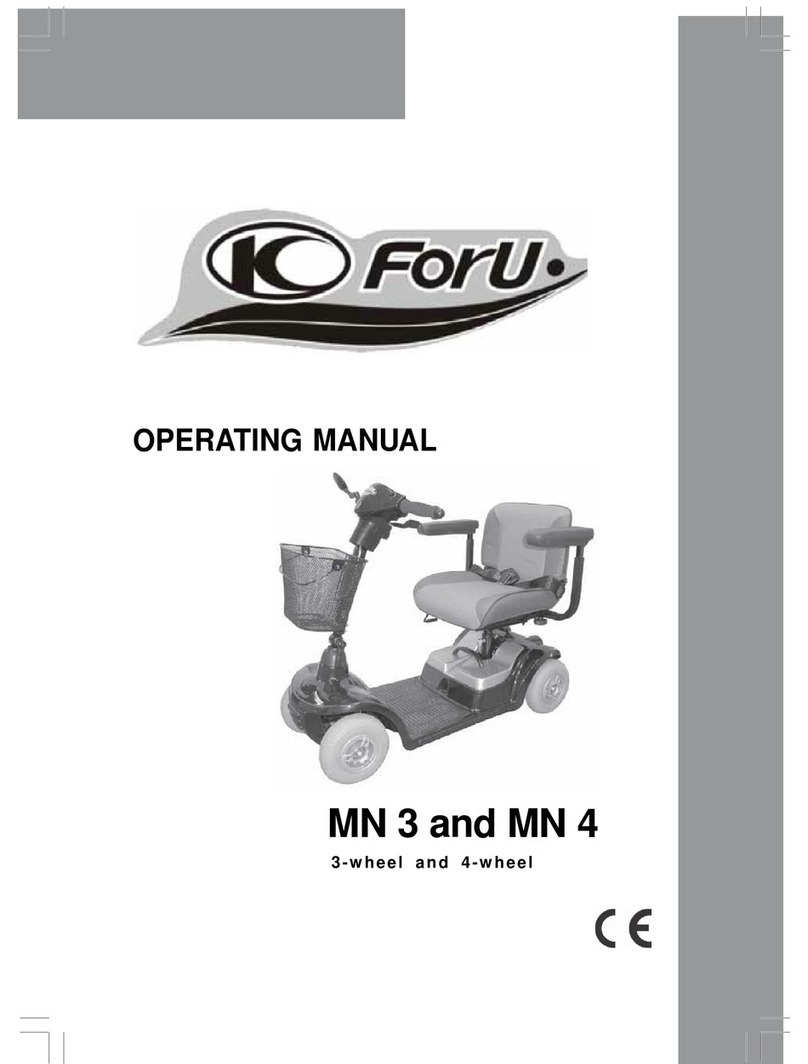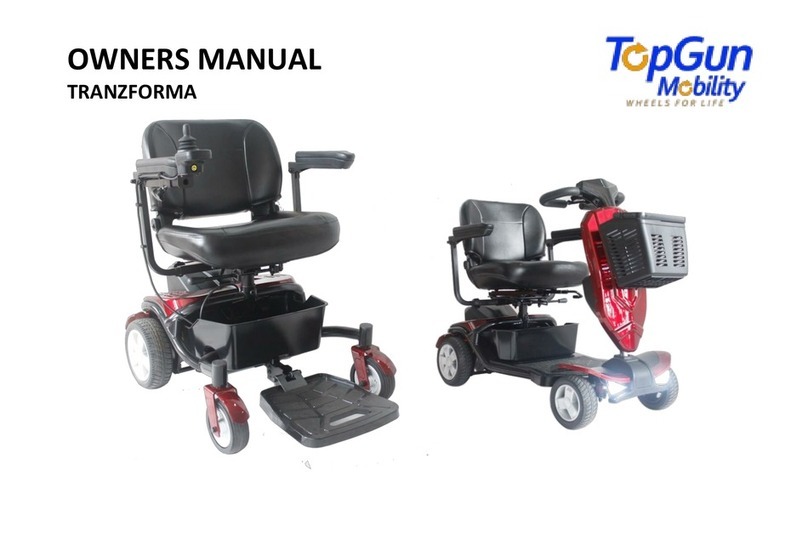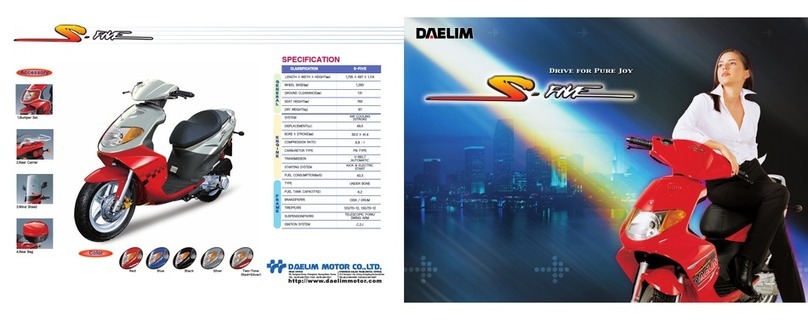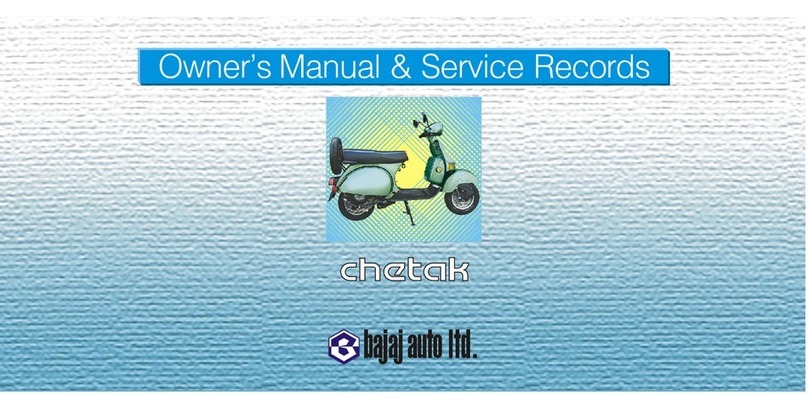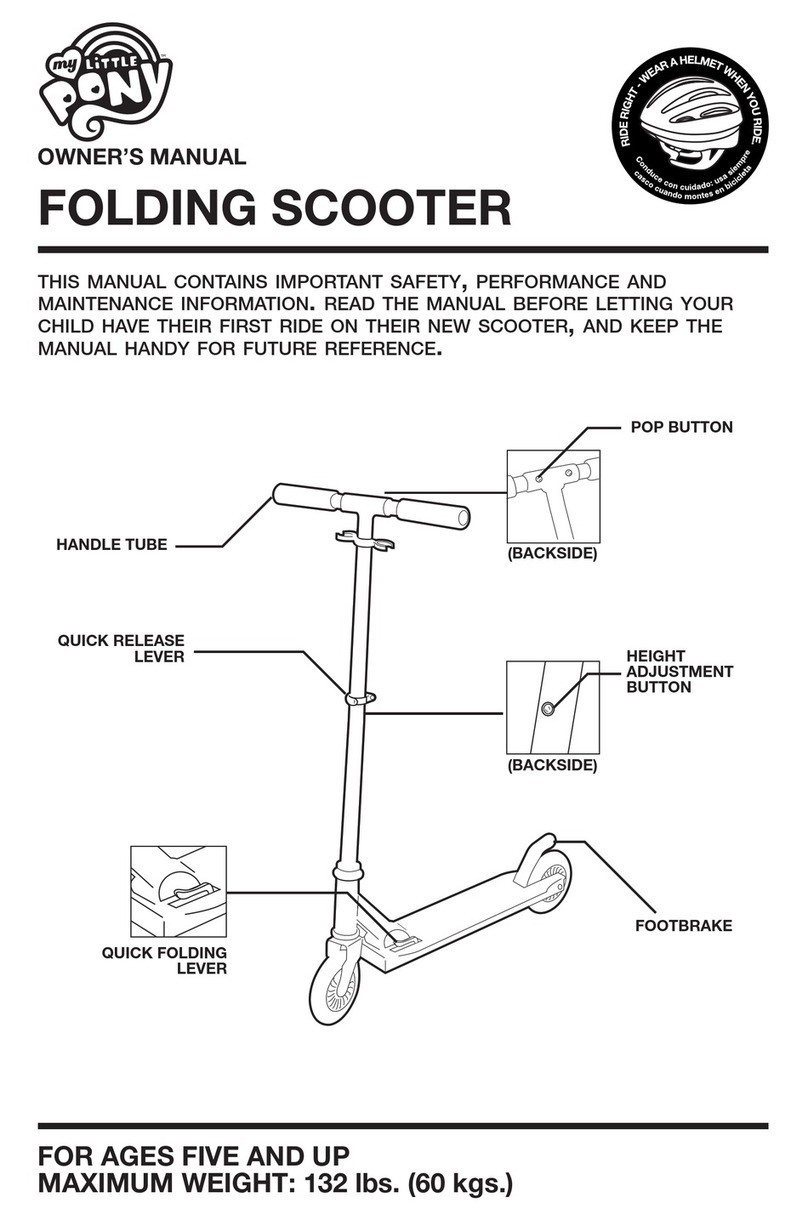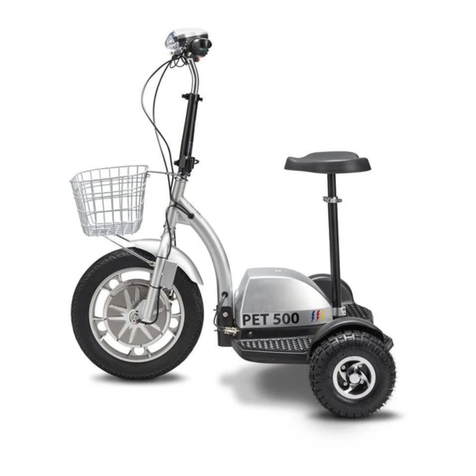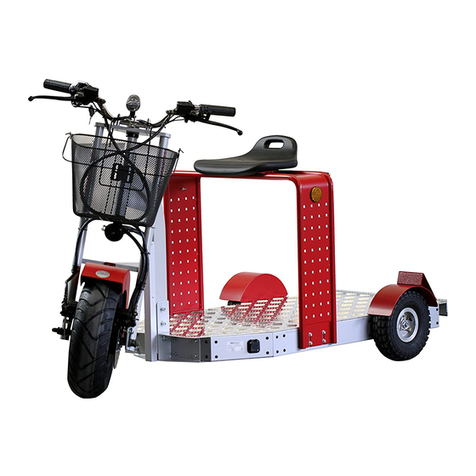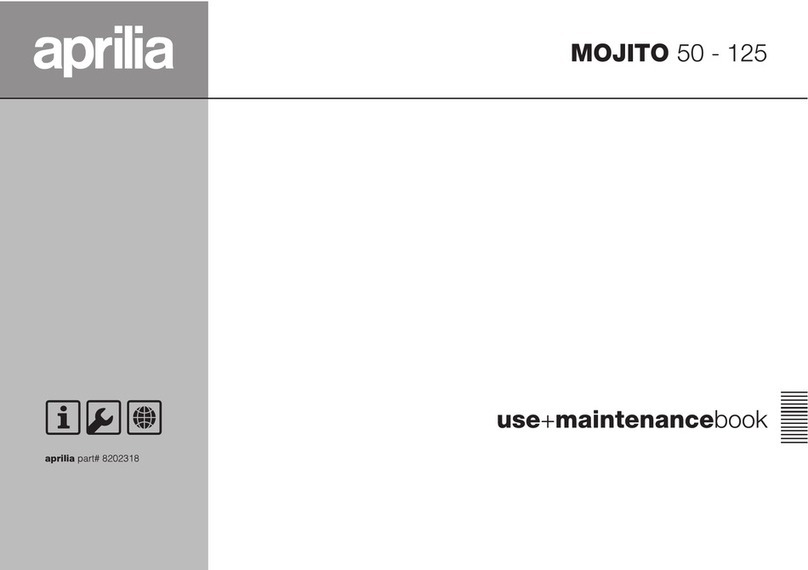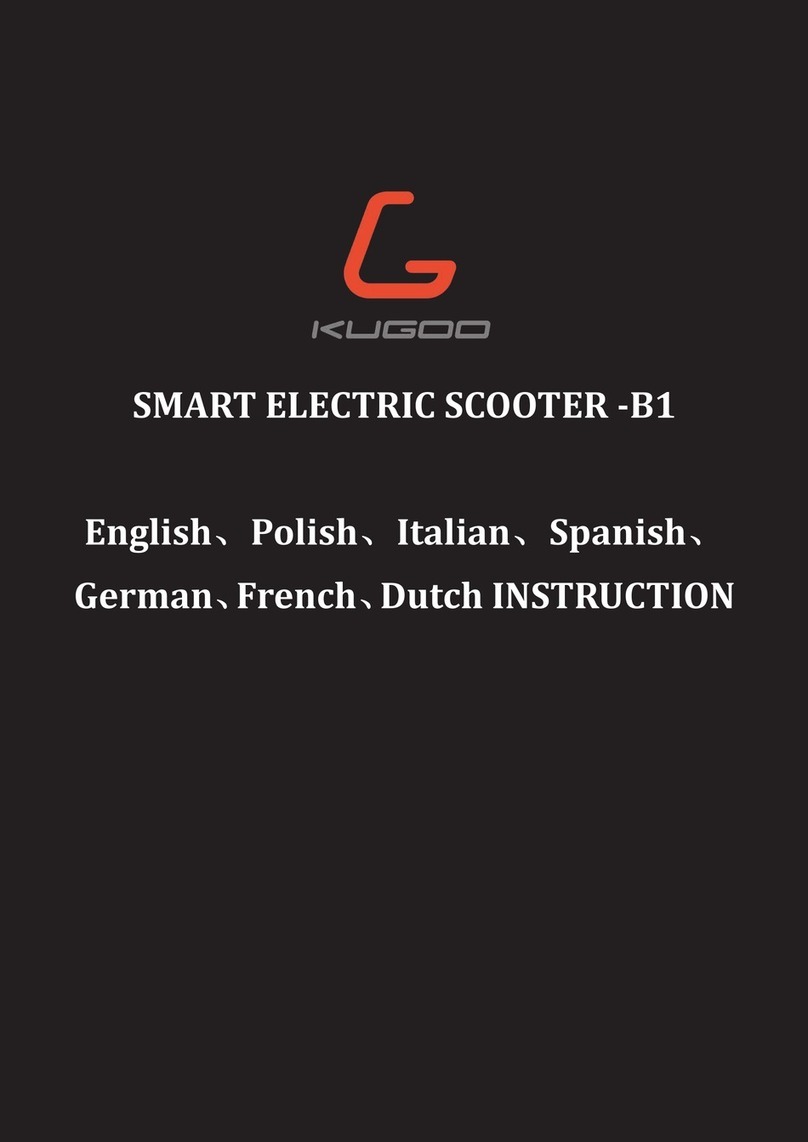Spokey ARMOR User manual

User manual
ARMOR
Before operating this vehicle, read all the instructions for safe assembly and operations.
User’s manual can guide you through the functions and usage of E-scooter. Before using
this E-scooter, familiarize yourself with how to operate, so that you can keep the
E-Scooter in the best condition possible.
This appliance can be used by children aged from 14 years and above and
persons with reduced physical, sensory or mental capabilities or lack of experience
and knowledge if they have been given supervision or instruction concerning use
of the appliance in a safe way and understand the hazards involved.
Children shall not play with the appliance.
Cleaning and user maintenance shall not be made by children without supervision.

⚫
Thank you for choosing and purchasing the electric handle scooter!
⚫
Handheld electric scooter is a new portable scooter designed mainly
by light weight and shape design.
⚫
Please carefully read the User’s Manual and understand security
warning and matters needing attention before use.
⚫
User’s Manual can help you know, use and maintain scooter rapidly.
⚫
Before you ride the product on road, please learn how to ride the
scooter safely to avoid collision, falling, losing control and other
dangers.
⚫
You can learn knowhows about safe riding through checking User’s
Manual.
⚫
The User’s Manual informs customer of all operating instructions and
matters needing attention, user of scooter must read the manual
carefully and operate according to requirements of the manual. If the
user does not operate the product according to hints or use of the
product violates warnings, the company will not undertake any
responsibility for all consequences generated.
⚫
If you would like to get related service support of the product, you
can contact with local agent or headquarter of the company.
I. Preparation Work before Riding
⚫
Please check if battery capacity is sufficient or not before use.
⚫
If you do not use the product according to security warnings, you may be
injured by the product.
II. Model Description of Handheld Electric Scooter

⚫
Handheld electric scooter is a convenient, light and handy, portable
electric scooter which is convenient for transfer. With advantages of
fashionable and light appearance, simple operation, flexible control,
low-carbon environmental protection etc., it is the best partner for leisure
and entertainment, riding during scenic tour and other applications in life.
III. Component Description of Two-Wheel Walking Intelligent Scooter
LCD DISPLAY
Familiarize yourself with the LCD display of E-Scooter. If the readout of the
LCD display of your E-Scooter is faded and unclear, you may need to
recharge your device.
SPEED INDICATOR
Displays your current speed in KM/H.
SPEED LEVEL INDICATOR
Displays your current speed level.
BATTERY LIFE INDICATOR
Displays your remaining battery life.
INFORMATION PANEL

Shows total mileage, distance traveled, battery, travel time traveled, etc.
BUTTON AND FUNCTIONS
①March + button: Serves to increase up to speed 3,
Speed vs Gear:
1 –Low –Gear-1: 6 km/h;
2 –Medium –Gear-2: 15 km/h;
3 –High –Gear-3: 24 km/h.
②On / off button:
1) Press and hold the button for 3 seconds to turn on or off;
2) Press the power button several times until VOL is displayed, the value
shown is the battery voltage (V);
3) Press the power button several times until it shows DIS, the value shown is
the distance traveled (KM);
4) Press the power button several times until ODO is displayed, the value that
shows the accumulated driving distance (KM);
5) Press the power button several times until it shows TIM, the value shown is
the duration in driving time (H).
3 March + button: Serves to reduce the speed to 1 ,

condition to avoid danger. Please do not ride the scooter horizontally on slop or
IV. Adjustment of Guide Device
Change direction Change direction
from left
from right
Please give a slight push according to direction shown in the drawing if
you want to change direction during riding.
V. Maintenance of Scooter
Maintenance of wheel and axle:
Lubricating oil is required to be added for the wheel and axle of the part pointed
by arrow regularly every week in order to avoid rusting and inflexibility,and avoid
affecting using. Please check front, rear wheel and axle carefully before using,
the tyre cannot have damage, blowout. If any problem is found, please contact
with after sale to change tyre.
Maintenance of screw:
Pleases add antirust oil for the screw of the part pointed by arrow regularly
every week, in order to avoid rusting, and affecting using. Please check the
screws of each part carefully before using, and the screw cannot have
looseness and dropping.
Remarks: Please check if the operation of machine is normal or not
carefully before using the scooter every time, if there is abnormality,
please do not use scooter forcibly and please contact with after sale for
maintenance. Please do not modify the structure of the machine arbitrarily
at will, if the structure is modified, you may be injured by the modification,
and the company will not undertake any responsibility for all
consequences generated by modifying the structure of the scooter
arbitrarily.
It is forbidden to change the direction of the scooter drastically in high-speed

change direction, which can lead to angular deflection of scooter and affect the
the scooter. When red indicator light of the charger lights, it indicates
riding safety. Please use electronic brake with caution during high-speed riding
to avoid wrestling.
VI. Riding and Using:
1. Nonzero startup: in order to guarantee riding safety, when the scooter
starts, the scooter is required to slide a certain distance. When the
speedometer displays the speed of above 3-5 km/h, accelerator can be
turned, that is the scooter can be driven by motor of the front wheel, for
normal riding. (optional)
2. Zero startup: turn the accelerator directly, the scooter can be driven by
motor of the front wheel, for normal riding (optional)
VII. Battery:
Display of battery capacity: when battery icon shows the battery level is empty,
it will flash rapidly, at this time, you are suggested to stop using the scooter and
charge the scooter. When battery level is too low, the scooter will not have
enough power for your normal riding. If you insist on riding the scooter, you may
probably fall down and cause injury, at the same time, service life of battery can
be influenced. If the following conditions incur, please do not use battery:
If the following conditions incur, please do not use battery:
⚫
There is some odors or heating is over high or any material leaks;
⚫
Only insiders can disassemble and maintain the battery;
⚫
If there is hazardous substance in battery, please do not open battery
arbitrarily and insert anything into battery;
⚫
Only matched charger can be used to charge the scooter;
⚫
It is forbidden to charge the lithium battery which has been discharged
overly, the lithium battery which is discharged overly has potential safety
hazard and can only be scrapped;
⚫
Battery of the scooter can only be used with permission of local laws;
⚫
Be careful not to let children contact the battery. Charger must be pulled
out before riding. Do anything related to the scooter is dangerous in
charging condition.
VIII. Charging Steps
⚫
Ensure port of charger is dry;
⚫
Open cover of charger of the scooter;
⚫
Insert one end of charger to electric supply (input AC 100 V-240 V: 50/60
HZ: output DC 42 V~2 A; according to requirements of order). Make sure
green light of the charger lights normally, insert the other end of charger to

charging is normal, otherwise please check if circuit is connected well or
not;
⚫
When indicator light of the charger turns green from red, it indicates the
scooter is fully charged, at this time, please stop charging, charging for
long time can affect the service life of the battery;
⚫
Pay attention to use local standard plug switch;
⚫
Please charge according to regulations and store the battery, otherwise
the battery will be damaged and service life of the battery will be affected;
⚫
Charging time of the scooter is about 3 hours;
⚫
Charging environment shall be clean and dry;
⚫
When port of the charger is moist, please do not charge;
⚫
When the charger is connected, you can turn on and turn off the scooter,
but the wheel can’t turn, it is forbidden to ride the scooter during charging.
IX. Weight Limitation of Driver
⚫
Reasons for weight limitation of driver:
1. Ensure safety of driver.
2. Reduce damage of overload on the scooter;
⚫
Maximum weight limitation of driver is 120 kilograms.
X. Speed Limitation
⚫
Max running speed of the scooter is 24 KM/H.
XI. Maximum Running Speed
⚫
After fully charged every time, maximum distance of travel is about 20 km;
⚫
Maximum distance of travel of the scooter is related to many factors, such
as: battery capacity, running speed, weight of riding etc;
⚫
Road condition: distance of travel can be increased when you ride the
scooter on smooth, flat ground, on the contrary, distance of travel can be
decreased;
⚫
Weight: weight of driver can affect the distance of travel.
XII. Riding Steps of the Scooter
Step 1: Press power switch and open the scooter;
Step 2: Riding preparation, set foot on footpad with one foot, the other foot
slides for a certain distance for run-up. When the speedometer displays the
speed of above 3-5 km/h, accelerator can be turned, that is the scooter can be
driven by motor of the front wheel, for normal riding.
Step 3: When you ride the scooter to make a turn, the speed should not be too
fast, please slow down. When you ride at high speed, please use electronic
brake with caution, if you need to slow down and break, please loose
accelerating steering handle to slow down and use electronic brake later.

XIII. About Safe Use
Diagram of Riding
⚫
Learner in the first stage shall select flat sliding field and wear elbow guard,
wrist guard, knee guard, helmet and other protective clothing during
sliding;
⚫
The aged, children, pregnant women cannot ride the scooter;
⚫
Please do not ride the scooter in condition of drinking, taking medicine;
⚫
Please alert to things ahead, keeping good vision is good for you to ride
the scooter better;
⚫
Please wear suitable gym suits to use the scooter, this is good for you to
handle with emergency;
⚫
Only one person is allowed to ride the scooter, it is forbidden to carry two
or above two;
⚫
Please control the speed within the safety range of you and others, so that
you can stop the operation of the scooter at any time;
⚫
When you change direction, please pay attention to the balance of the
center of the gravity of body to prevent falling because of shift of center of
gravity and excessively fast speed;
⚫
It is forbidden to run on wet road in rainy day, ride the scooter over speed
for a long distance;
⚫
Avoid riding on smooth ground with obstacles, such as: snowfield, ice land,
wet ground and floor etc.;
⚫
Avoid riding badly lighted or dark place and avoid riding on road with
garbage or small stone, odds;
⚫
Please do not stop suddenly and ride the scooter on steep slope;
⚫
Please obey local traffic rules, yield to pedestrians during riding the
scooter;
⚫
Please select flat road with good sight of road, no plash during ride the
scooter;
⚫
Environment temperature: pleases place the scooter in shade and cool,
dry place when the scooter is not used. If you ride the scooter in
recommended storage conditions, distance of travel can be increased, on
the contrary, distance of travel can be decreased under extreme
temperature;

⚫
Speed and riding style: keeping medium speed can increase distance of
travel, on the contrary, starting, stopping, accelerating, decelerating
frequently can reduce distance of travel;
⚫
Maintenance: reasonable charging and maintenance of the battery can
increase distance of travel, on the contrary, distance of travel can be
decreased.
Please wear arm guard, wrist guard, knee guard, helmet and elbow guard
before riding the scooter, running and jumping on the scooter are
extremely dangerous, please ride the scooter carefully with caution.
XIV. Excessively High Temperature or Excessively Low Temperature
⚫
If you would like to have the highest operating efficiency of the scooter,
temperature of the battery must within the temperature range marked in
specifications of the battery;
⚫
Temperature must be controlled within recommended value before
charging and during charging, when temperature is near recommended
temperature, charging efficiency is the highest. If environment is too cold
or too overheated, charging time can be lengthened or the battery cannot
be charged fully.
XV. Detailed Parameters of Battery
Name
Parameter
Type of Battery
Lithium battery
Charging Time
About 3 hours (battery capacity is different
with specification of charger, charging time
can be changed.)
Normal Voltage
36 V
Initial Capacity
6.0 AH
Operating Temperature
-20℃-50 ℃
Charging Temperature
0℃~45 ℃
Storage Temperature
-20℃~60 ℃
XVI. Matters Needing Attention during Transporting Battery
Lithium battery is considered as dangerous article, permission of local laws is
required during transportation.

If you need to transport the battery of scooter loaded with lithium battery by air,
or you need to adopt any other transport methods to transport lithium battery of
the scooter independently, please contact with the company or assigned
agent.
It is forbidden to use high-pressure hydraulic giant to clean the scooter or
immerse the scooter in liquid to clean the scooter.
Penetration of water or other liquid into the scooter shall be avoided to prevent
electronics within host machine from damaging permanently.
XVII. Storage
⚫
Please charge the scooter before storage to prevent over discharging
because the scooter is not used for a long time;
⚫
If the scooter is stored for more than one month, please take out the
battery and store the scooter, and guarantee at least one time of full
discharging every three months;
⚫
If temperature of storage environment is lower than 0 ℃, please do not
charge the scooter, the scooter can be placed in warm environment
(higher than 10℃) to charge;
⚫
You can cover the scooter to prevent influence on performance because of
dirt detention;
⚫
Please store the scooter in a dry room with proper temperature.
⚫
For your own safety, please don’t disassemble the scooter without our
authorization, otherwise, the warranty of the product will be void.
XVIII. Parameters
Detailed Parameters
Name
Parameter
Remarks
Net Weight
About 16.8 kg
Minimum Load
20 kg
Maximum Load
120 kg
Highest Speed per Hour
24km/h
Maximum Endurance
About 20 KM
With the difference of

Distance
topography, riding mode
and load, distance can be
different.
Maximum Climbing Angle
15
°
Optional
Turn Radius
0°
Energy
Chargeable lithium battery
Charging Requirement
DC 42 V~2 A
Length * Width * Height
Unfolded: 128*113*44.5 mm
Battery
36 V/6.0Ah
Operating Temperature
0-40 ℃
XIX. Packing List
NO.
Name of Product
Qty
1
Host machine
1 set
2
Charger
1 charger
3
Instruction manual
1 book

Instrukcja
ARMOR
Przed rozpoczęciem użytkowania tego produktu należy zapoznać się z instrukcją
bezpiecznego montażu i obsługi. Instrukcja obsługi dostarcza informacji odnośnie funkcji
oraz użycia hulajnogi elektrycznej. Przed pierwszym użyciem produktu prosimy
zapoznać się ze sposobem jego obsługi, tak aby zachować produkt w najlepszym
możliwym stanie.
To urządzenie może być użytkowane przez dzieci od 14 roku życia oraz osoby o
ograniczonej zdolności fizycznej, sensorycznej oraz umysłowej, a także osoby
niedoświadczone lub nieposiadające wiedzy, pod warunkiem uzyskania nadzoru lub
instruktażu dotyczącego bezpiecznego użycia produktu i zrozumienia możliwych
zagrożeń w tym zakresie.
Dzieci nie powinny bawić się produktem.
Dzieci bez nadzoru osoby starszej nie mogą czyścić, ani serwisować produktu.

•Dziękujemy za wybór oraz zakup hulajnogi elektrycznej!
•Hulajnoga elektryczna to urządzenie nowej generacji charakteryzujące
się przede wszystkim niską wagą oraz atrakcyjnym wyglądem.
•Przed użyciem prosimy dokładnie zapoznać się z instrukcją obsługi oraz
zrozumieć ostrzeżenia i kwestie wymagające uwagi.
•Instrukcja obsługi pomaga zapoznać się, użytkować oraz serwisować
hulajnogę w sposób poprawny.
•Przed wjazdem na drogę, należy nauczyć się bezpiecznej obsługi
hulajnogi w celu uniknięcia kolizji, upadku, utraty kontroli lub innych
zagrożeń.
•Instrukcja obsługi dostarcza informacji odnośnie bezpiecznej jazdy na
hulajnodze.
•Instrukcja przedstawia także wszelkie instrukcje użytkowania oraz
kwestie wymagające uwagi; użytkownik hulajnogi ma obowiązek
dokładnie zapoznać się z instrukcją oraz użytkować produkt zgodnie z
wymogami. W przypadku obsługi produktu niezgodnie ze wskazówkami
lub gdy użycie produktu odbywa się wbrew ostrzeżeniom, nie ponosimy
odpowiedzialności za ewentualne konsekwencje takich działań.
•W razie potrzeby uzyskania wsparcia serwisowego, prosimy o kontakt z
lokalnym przedstawicielem lub z siedzibą firmy.
I. Przygotowania przed rozpoczęciem jazdy
•Przed użyciem należy sprawdzić poziom naładowania baterii.
•W przypadku korzystania z produktu niezgodnie z ostrzeżeniami, może dojść
do obrażeń ciała.
II. Opis modelu hulajnogi elektrycznej

•Hulajnoga elektryczna to wygodne, lekkie oraz poręczne urządzenie
mobilne służące do komfortowego przemieszczania się. Dzięki atrakcyjnej i
lekkiej budowie, prostej obsłudze, elastycznemu sterowaniu, technologii pro-
środowiskowej, produkt ten to doskonały wybór gwarantujący odpoczynek i
zabawę, a także jazdę w malowniczym terenie i wiele innych zastosowań.
III. Opis komponentów inteligentnej hulajnogi elektrycznej
WYŚWIETLACZ LCD
Należy zapoznać się z wyświetlaczem LCD hulajnogi. Jeśli wskazanie na
wyświetlaczu jest niewyraźne i nieczytelne, należy naładować urządzenie.
WSKAZANIE PRĘDKOŚCI
Aktualna prędkość wyświetlana jest w KM/H.
WSKAŹNIK POZIOMU PRĘDKOŚCI
Wyświetla aktualny poziom prędkości.
WSKAŹNIK STANU BATERII
Wyświetla poziom baterii.
PANEL INFORMACYJNY

Przedstawia łączny przebieg, pokonany dystans, stan baterii, czas podróży, itd.
PRZYCISK I FUNKCJE
①Przycisk poziomu prędkości (+): zwiększa prędkość do 3
Wcisnąć, aby zwiększyć prędkość oraz przyspieszenie. 1 – niskie, 2 –średnie, 3 –
wysokie.
Prędkość vs. Przełożenie:
Przełożenie-1: 6 km/h,
Przełożenie-2: 15 km/h,
Przełożenie-3: 24 km/h
②Przycisk ON/OFF:
1) Wcisnąć i przytrzymać przycisk przez 3 sekundy, aby włączyć lub wyłączyć;
2) Wcisnąć przycisk zasilania kilka razy do momentu pojawienia się VOL,
wartość przedstawia napięcie baterii (V);
3) Wcisnąć przycisk zasilania kilka razy do momentu pojawienia się DIS, wartość
przedstawia pokonany dystans (KM);
4) Wcisnąć przycisk zasilania kilka razy do momentu pojawienia się ODO, wartość
przedstawia łącznie pokonany dystans (KM);
5) Wcisnąć przycisk zasilania kilka razy do momentu pojawienia się TIM, wartość
przedstawia czas trwania jazdy (H).
③Przycisk poziomu prędkości (-) : służy do zmniejszenia prędkości do -1.
Wcisnąć, aby zmniejszyć prędkość i przyspieszenie.
IV. Zmiana kierunku jazdy

Zmiana kierunku w lewo Zmiana kierunku w prawo
Delikatnie pchnąć zgodnie ze wskazanym kierunkiem na ilustracji w
przypadku zamiaru zmiany kierunku podczas jazdy.
V. Konserwacja hulajnogi
Konserwacja koła oraz osi:
W zakresie koła oraz osi części wskazanej strzałką należy regularnie (tj.
cotygodniowo) aplikować olej smarowy w celu uniknięcia rdzewienia oraz
utraty elastyczności, a także wadliwego działania. Sprawdzić dokładnie
przednie oraz tylne koło i oś przed obsługą. Opony nie mogą mieć śladów
uszkodzeń czy pęknięć. W razie jakichkolwiek problemów, prosimy o kontakt
z działem obsługi po-sprzedażowej w celu wymiany opony.
Konserwacja śrub:
W zakresie śruby części wskazanej strzałką należy regularnie (cotygodniowo)
aplikować olej przeciwrdzewny w celu uniknięcia rdzewienia i wadliwej pracy.
Sprawdzić śruby każdej części przed użyciem, śruby nie mogą mieć luzów,
ani nie mogę wisieć.
Uwagi: Należy zawsze dokładnie sprawdzać czy praca urządzenia jest
poprawna przed obsługą hulajnogi. W razie nieprawidłowości, nie
przeciążać hulajnogi i skontaktować się z działem obsługi po-
sprzedażowej w celu przeprowadzenia konserwacji. Nie modyfikować
konstrukcji produktu na własną rękę; w razie takiej modyfikacji może
dojść do obrażeń ciała, a my nie ponosimy odpowiedzialności za
wszelkie konsekwencje wynikające z modyfikacji konstrukcji na własną
rękę.

Zabrania się nagłej zmiany kierunku jazdy hulajnogi przy wysokiej prędkości
w celu uniknięcia zagrożeń. Nie jeździć na hulajnodze poziomo na
wzniesieniu lub zmieniać kierunku, gdyż może to prowadzić do zmiany
kierunku i wpływać na bezpieczeństwo jazdy. Korzystać z elektronicznego
hamulca z uwagą w czasie szybkiej jazdy, aby uniknąć upadku.
VI. Jazda i obsługa:
1. Rozruch dłuższy: w celu zapewnienia bezpieczeństwa jazdy, po
uruchomieniu hulajnogi pojazd musi zjechać pewien dystans. Gdy
prędkościomierz wskaże prędkość powyżej 3-5hm/h, można włączyć
przyspieszenie, tzn. hulajnogę można napędzić silnikiem przedniego koła,
w zakresie normalnej jazdy (opcjonalnie)
2. Rozruch krótszy: włączyć przyspieszenie od razu, hulajnogę można
napędzić silnikiem przedniego koła, w zakresie zwykłej jazdy (opcjonalnie)
VII. Bateria:
Wyświetlacz stanu baterii: gdy ikona baterii wskaże, że jej poziom jest zerowy,
zacznie gwałtownie mrugać; w tym czasie zaleca się zaprzestanie dalszego
użycia hulajnogi i naładowanie produktu. Gdy poziom baterii jest zbyt niski,
hulajnoga nie będzie miała wystarczającej mocy, aby zapewnić normalną
jazdę. Jeśli mimo to użytkownik postanowi kontynuować jazdę, może upaść
oraz doznać obrażeń, jednocześnie ma to negatywny wpływ na żywotność
baterii.
W razie wystąpienia poniższych, nie należy korzystać z baterii:
•Nadmierne wydzielanie zapachów lub nadmierne przegrzewanie lub wyciek
materiałów;
•Do demontażu oraz konserwacji baterii upoważnieni są wyłącznie osoby
kompetentne;
•W przypadku obecności substancji niebezpiecznej w baterii, nie otwierać
baterii na własną rękę i nie wkładać niczego do baterii;
•Do ładowania hulajnogi stosować wyłącznie odpowiednią ładowarkę;
•Zabrania się ładowania baterii litowej, która została nadmiernie wyładowana;
taka bateria stanowi potencjalne zagrożenie oraz nadaje się wyłącznie do
utylizacji;
•Bateria hulajnogi może być wykorzystywana wyłącznie zgodnie z prawem
lokalnym;
•Nie dopuścić, aby dzieci miały kontakt z baterią. Przed jazdą ładowarkę
należy wyciągnąć. Jakiekolwiek działania związane z hulajnogą stanowią
zagrożenie w czasie jej ładowania.

VIII. Ładowanie
•Upewnić się, że port ładowarki jest suchy;
•Otworzyć pokrywę ładowarki hulajnogi;
•Wprowadzić jeden koniec ładowarki do źródła zasilania elektrycznego
(wejście AC 100 V-240 V: 50/60 HZ: wyjście DC 42 V~2 A; zgodnie z
wymogami zamówienia). Upewnić się, że zielona dioda ładowarki świeci się
prawidłowo, umieścić drugi koniec ładowarki w hulajnodze. Gdy zapali się
czerwona dioda ładowarki, oznacza to, że ładowanie jest prawidłowe. W
przeciwnym wypadku sprawdzić połączenie;
•Gdy dioda ładowarki zmieni kolor z czerwonego na zielony, oznacza to, że
nastąpiło pełne naładowanie hulajnogi. W tym momencie należy przestać
ładować produkt, gdyż zbyt długie ładowanie ma negatywny wpływ na
żywotność baterii;
•Należy stosować lokalnie obowiązującą wtyczkę;
•Ładować oraz przechowywać baterię zgodnie z przepisami, w przeciwnym
wypadku bateria ulegnie uszkodzeniu, a jej żywotność zostanie skrócona;
•Czas ładowania hulajnogi wynosi około 3 godzin;
•Miejsce ładowania powinno być czyste i suche;
•Gdy port ładowarki jest wilgotny, nie ładować;
•Po podłączeniu ładowarki, można włączyć lub wyłączyć hulajnogę, ale koła
nie będą się obracać; zabrania się jazdy na hulajnodze w czasie ładowania.

IX. Ograniczenia wagowe
•Przyczyny ograniczenia wagowego dla użytkownika:
1. Zapewnienie bezpieczeństwa użytkownika.
2. Ograniczenie uszkodzeń w wyniku przeciążenia hulajnogi.
Maksymalna waga użytkownika to 120 kilogramów.
X. Ograniczenie prędkości
•Maksymalna prędkość hulajnogi wynosi 24 km/h.
XI. Maksymalna prędkość jazdy
•Po pełnym naładowaniu maksymalny możliwy dystans do pokonania wynosi
około 20 km;
•Maksymalny dystans zależy od wielu czynników, tj. pojemności baterii,
prędkości jazdy, obciążenia, itd.;
•Stan drogi: dystans do pokonania można zwiększyć w przypadku jazdy na
gładkiej, płaskiej drodze, z drugiej strony dystans ten skraca się w przypadku
innych warunków;
•Waga: waga użytkownika może wpłynąć na dystans do pokonania.
XII. Jazda na hulajnodze
Krok 1: Wcisnąć przycisk zasilania i uruchomić hulajnogę;
Krok 2: Przygotowanie do jazdy. Ustawić jedną stopę na pedale nożnym, a drugą
nogę przesunąć na pewną odległość w celu rozbiegu. Gdy prędkościomierz
wskaże prędkość powyżej 3-5 km/h, przyspieszenie można włączyć, a hulajnogę
można będzie napędzić silnikiem przedniego koła.
Krok 3: Przed wykonaniem skrętu podczas jazdy, prędkość hulajnogi nie powinna
być zbyt wysoka, należy zwolnić. W czasie jazdy z dużą prędkością, należy
korzystać z hamulca elektronicznego z rozwagą. Przed zwolnieniem i
zatrzymaniem, zwolnić uchwyt przyspieszania, a następnie wykorzystać hamulec
elektroniczny.
XIII. Bezpieczne użytkowanie
Schemat jazdy
•Na pierwszym etapie użytkownik powinien wybrać płaską powierzchnię i
stosować ochronę łokci, nadgarstków, kolan, a także kask i inną odzież
zabezpieczającą na wypadek poślizgu;
•Osoby starsze, dzieci oraz kobiety w ciąży nie mogą korzystać z hulajnogi;

•Nie korzystać z hulajnogi po spożyciu alkoholu lub po przyjęciu leków;
•Zwrócić uwagę na obiekty na swojej drodze, zapewnienie dobrej widoczności
usprawnia jazdę;
•Stosować odpowiednią odzież do jazdy na hulajnodze, ma to zastosowanie w
razie nagłych wypadków;
•Tylko jedna osoba może obsługiwać hulajnogę; zabrania się transportowania
dwóch lub więcej osób;
•Kontrolować prędkość swoją i innych, tak aby była możliwość zatrzymania
hulajnogi w dowolnym momencie;
•W czasie zmiany kierunku, zwrócić uwagę na środek ciężkości ciała, aby
uniknąć upadku ze względu na przesunięcie środka ciężkości oraz nadmierną
prędkość;
•Zabrania się jazdy na mokrej nawierzchni w deszczowy dzień, a także jazdy z
nadmierną prędkością na długich dystansach;
•Unikać jazdy na gładkiej powierzchni z przeszkodami, tj. zaśnieżonym terenie,
na lodzie, na mokrej nawierzchni oraz podłożu, itd.;
•Unikać jazdy przy nieodpowiednim oświetleniu lub w miejscu zaciemnionym,
a także unikać jazdy na drodze z odpadami lub małymi kamieniami;
•Nie zatrzymywać gwałtownie hulajnogi i nie jeździć na stromym stoku;
•Przestrzegać lokalnych przepisów ruchu, ustępować pierwszeństwa pieszym
w czasie jazdy;
•Wybrać płaską drogą z dobrą widocznością, unikać zachlapań w trakcie
jazdy;
•Temperatura otoczenia: gdy nie jest używana, umieścić hulajnogę w
zaciemnionym oraz chłodnym i suchym miejscu. W przypadku stosowania się
do zalecanych warunków przechowywania, dystans do pokonania może się
zwiększyć; z drugiej strony może być krótszy jeśli temperatury są skrajne;
•Prędkość i styl jazdy: zachowanie średniej prędkości może zwiększyć możliwy
dystans, jednak częste uruchamianie, zatrzymywanie, przyspieszanie i
zwalnianie może prowadzić do skutku odwrotnego;
•Konserwacja/serwis: odpowiednie ładowanie oraz konserwacja baterii może
prowadzić do zwiększenia dystansu jazdy; w przeciwnym wypadku dojdzie do
sytuacji odwrotnej.
Stosować ochronę ramion, nadgarstka, kolan, łokci, a także kask w
czasie jazdy. Podskakiwanie na hulajnodze jest niezwykle
niebezpieczne, dlatego należy obsługiwać produkt ostrożnie.
XIV. Nadmiernie wysoka lub niska temperatura
•W przypadku chęci zapewnienia maksymalnej wydajności hulajnogi,
Table of contents
Languages:
Other Spokey Scooter manuals
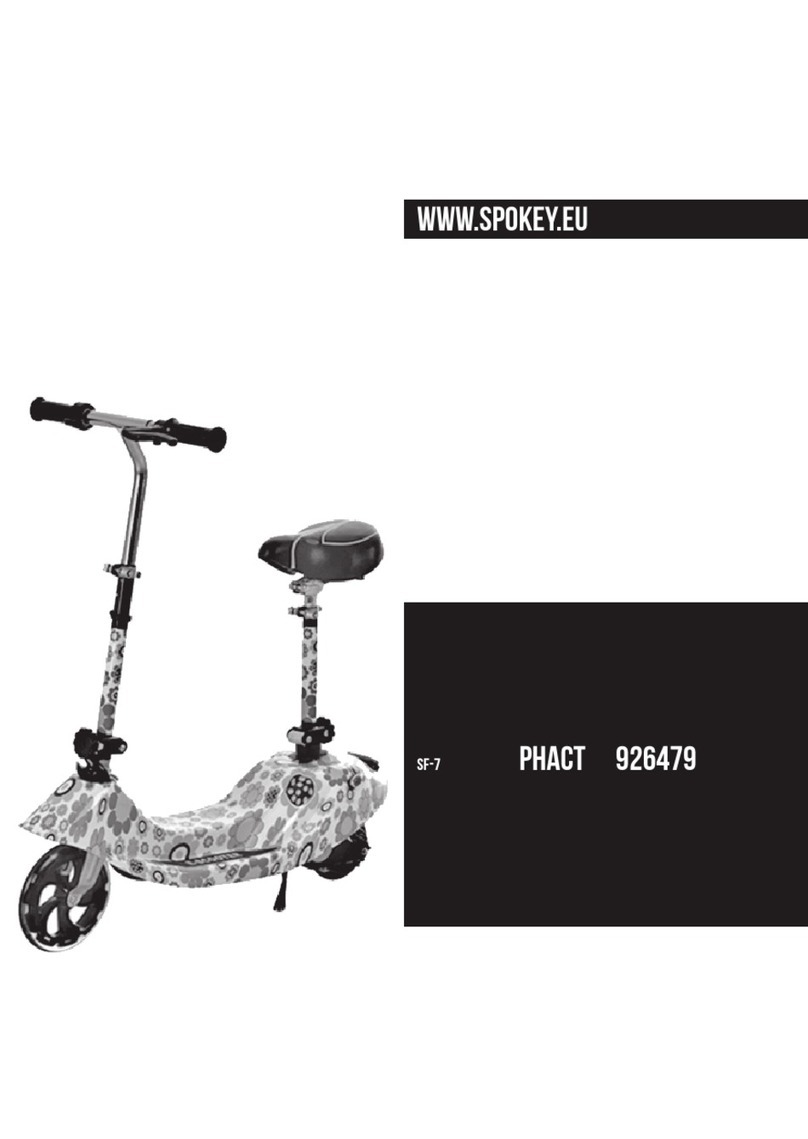
Spokey
Spokey PHACT User manual
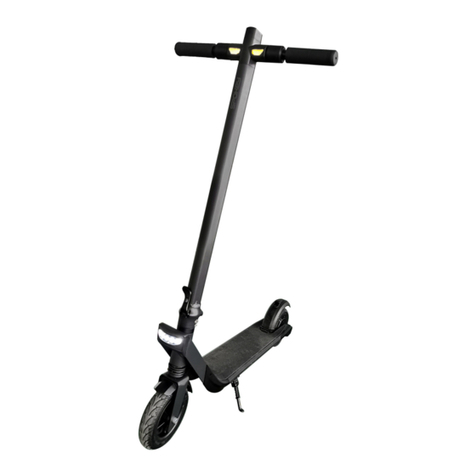
Spokey
Spokey GHOST User manual

Spokey
Spokey KEID-926477 User manual

Spokey
Spokey QUEST 926738 User manual
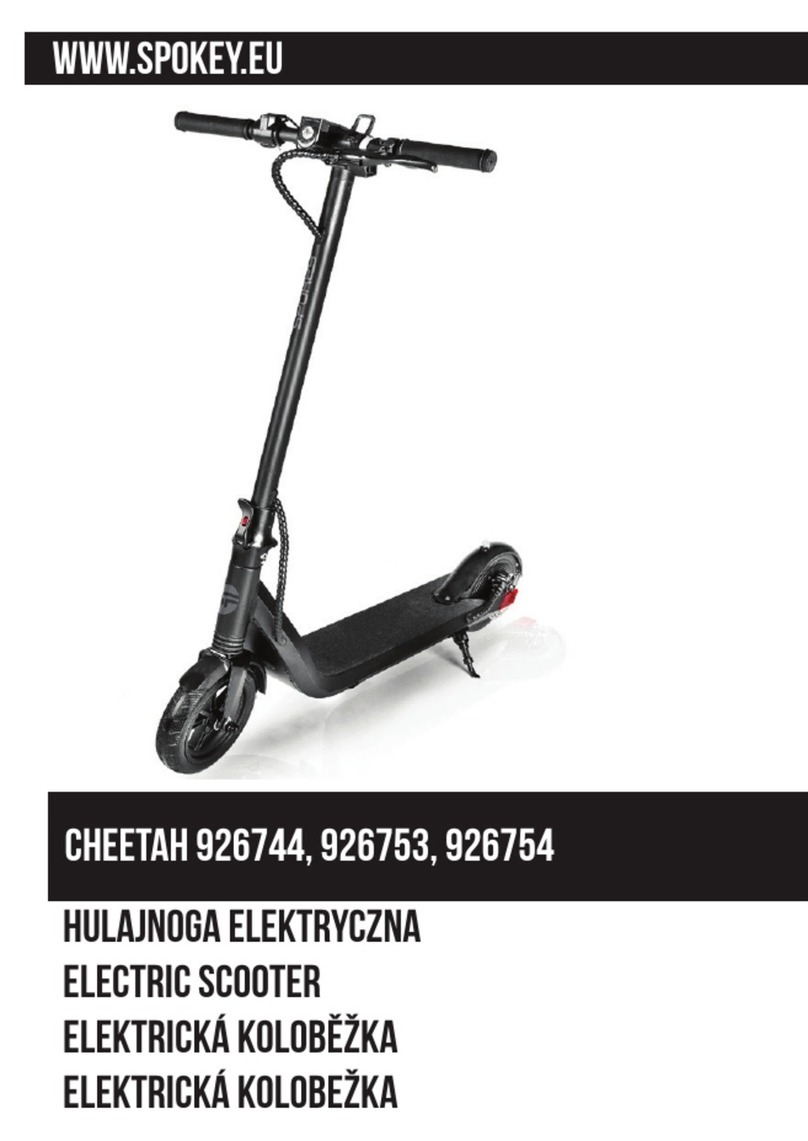
Spokey
Spokey CHEETAH 926744 User manual
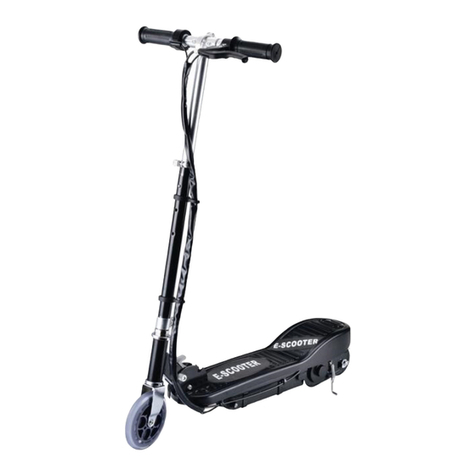
Spokey
Spokey ENIF User manual

Spokey
Spokey VENOM User manual
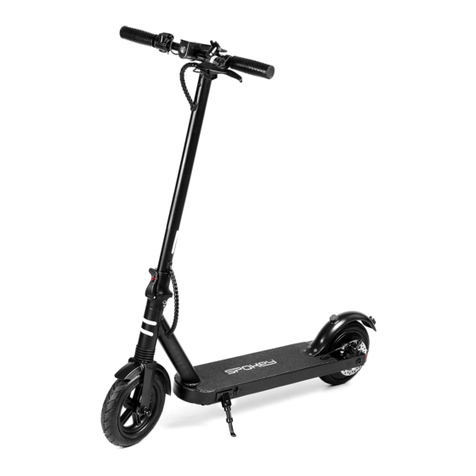
Spokey
Spokey SHAMAN User manual
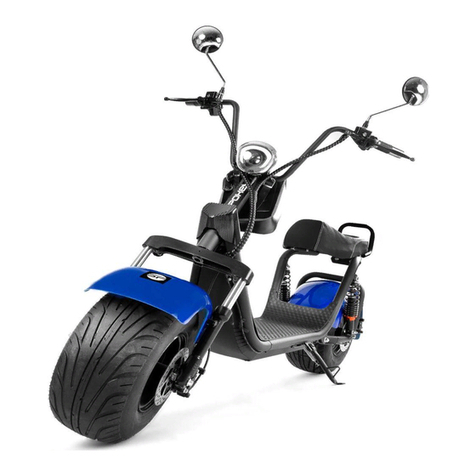
Spokey
Spokey BIG BOSS 926484 User manual
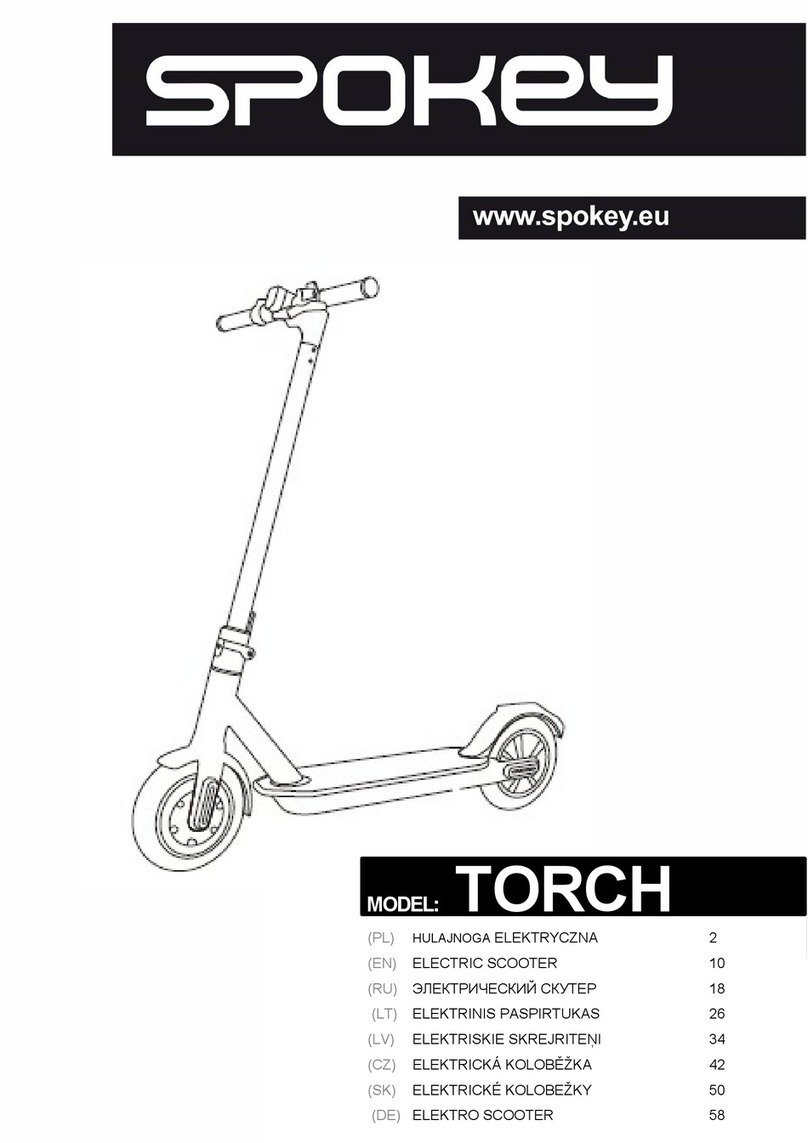
Spokey
Spokey TORCH User manual
